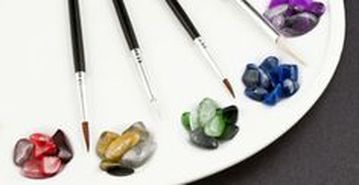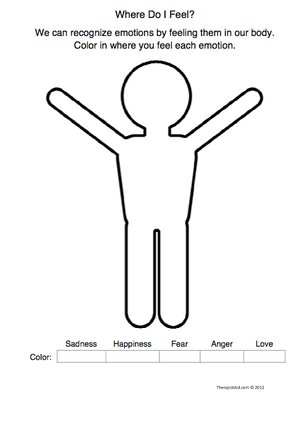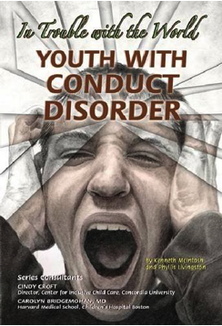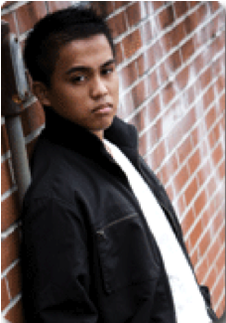Conduct Disorder

"Conduct disorder" refers to a group of behavioral and emotional problems in youngsters. Children and adolescents with this disorder have great difficulty following rules and behaving in a socially acceptable way. They are often viewed by other children, adults and social agencies as "bad" or delinquent, rather than mentally ill. Many factors may contribute to a child developing conduct disorder, including brain damage, child abuse, genetic vulnerability, school failure, and traumatic life experiences.
https://www.aacap.org/aacap/Families_and_Youth/Resource_Centers/Conduct_Disorder_Resource_Center/Home.aspx
https://www.aacap.org/aacap/Families_and_Youth/Resource_Centers/Conduct_Disorder_Resource_Center/Home.aspx
"CD (conduct disorder) will be defined on the basis of the presence of three of 15 criteria that should have been present in the last 12 months, and of which one must have been present in the past 6 months. These 15 behavioural criteria can be categorized into four generalized behavioural subtypes: (1) aggression to people and animals, (2) destruction of property, (3) deceitfulness or theft and (4) serious violations of rules.
Conduct disorders
Jan K. Buitelaar • Kirsten C. Smeets •Pierre Herpers • Floor Scheepers • Jeffrey Glennon • Nanda N. J. Rommelse
Conduct disorders
Jan K. Buitelaar • Kirsten C. Smeets •Pierre Herpers • Floor Scheepers • Jeffrey Glennon • Nanda N. J. Rommelse

Traits in Children and Adolescents
High novelty Seeking
David C. Rettew4, Catherine Stanger, Laura McKee, Alicia Doyle, James J. Hudzia
High novelty Seeking
- externalizing problems and disorders
- early onset antisocial behaviour
- Diagnostic and Statistical Manual of Mental Disorders, Fourth Edition conduct disorder
- disruptive behaviour
- attention problems
- high levels of harm avoidance
- manly linked with internalizing disorders in children and adolescents
David C. Rettew4, Catherine Stanger, Laura McKee, Alicia Doyle, James J. Hudzia
Relationship between Depression and Conduct Disorder in Children and Adolescents
KEITH MARRIAGE, M.B., F.R.C.P.(C), STUART FINE, M.B., F.R.C.P.(C)MARLENE MORETTI, M.A.GLENN HALEY, M.A.
In this journal is says that, of 60 children and adolescents referred for assessment of depression, 11 cases were found which met diagnostic criteria for both conduct disorder and affective disorder. These 11 subjects could not be distinguished from those with major depression on the basis of psychiatric ratings of depressive symptoms—both diagnostic groups were characterized by multiple depressive symptoms of high severity. Psychiatric ratings also indicated that depressive symptoms were more severe in cases of conduct disorder with depression than in cases of dysthymic disorder. Child and adolescent self-reports of depression were consistent with this pattern of results.
http://www.jaacap.com/article/S0002-7138%2809%2960295-8/abstract
KEITH MARRIAGE, M.B., F.R.C.P.(C), STUART FINE, M.B., F.R.C.P.(C)MARLENE MORETTI, M.A.GLENN HALEY, M.A.
In this journal is says that, of 60 children and adolescents referred for assessment of depression, 11 cases were found which met diagnostic criteria for both conduct disorder and affective disorder. These 11 subjects could not be distinguished from those with major depression on the basis of psychiatric ratings of depressive symptoms—both diagnostic groups were characterized by multiple depressive symptoms of high severity. Psychiatric ratings also indicated that depressive symptoms were more severe in cases of conduct disorder with depression than in cases of dysthymic disorder. Child and adolescent self-reports of depression were consistent with this pattern of results.
http://www.jaacap.com/article/S0002-7138%2809%2960295-8/abstract

Art therapy with adolescents
In art therapy, the client is asked to make a collage, make some marks on paper, or shape a small piece of clay to illustrate the difficulties that have brought them to therapy. The art therapist does not interpret the art piece, and the clients are free to share as much of the meaning of their art as they choose. Adolescents, in particular, are attracted to making symbols and graphic depictions; therefore, they are more attracted to using art as language than to verbal questioning. When the negative behavior is illustrated, it is then external to the individual, and the behavior thus becomes the problem, not the individual.
This externalization of an internal stress or by the creation of “nonartistic art” allows both the therapist and the client to better address the problem. The therapist gains greater knowledge of the problem because the client uses metaphor and narrative to explain the product. The “art” allows clients to distance themselves from their own dilemma and, in that manner, work with the therapist toward alternative solutions to a problem.
http://www.ncbi.nlm.nih.gov/pmc/articles/PMC1071468
In art therapy, the client is asked to make a collage, make some marks on paper, or shape a small piece of clay to illustrate the difficulties that have brought them to therapy. The art therapist does not interpret the art piece, and the clients are free to share as much of the meaning of their art as they choose. Adolescents, in particular, are attracted to making symbols and graphic depictions; therefore, they are more attracted to using art as language than to verbal questioning. When the negative behavior is illustrated, it is then external to the individual, and the behavior thus becomes the problem, not the individual.
This externalization of an internal stress or by the creation of “nonartistic art” allows both the therapist and the client to better address the problem. The therapist gains greater knowledge of the problem because the client uses metaphor and narrative to explain the product. The “art” allows clients to distance themselves from their own dilemma and, in that manner, work with the therapist toward alternative solutions to a problem.
http://www.ncbi.nlm.nih.gov/pmc/articles/PMC1071468
How does art help?
Art helps because it gives the child or adolescent an escape rope for allowing them to express their emotions through painting, sculpture, music and other arts forms. "It is also a way for parents to understand the origin of the aggressiveness. When your child is angry, encourage him to paint or express their feelings through art, rather than acting physically."
http://earlychildhoodeducationwebsites.blogspot.ca/2012/08/Activities-for-children-with-aggressive-attitudes-How-to-reduce-your-childs-aggression-Ways-to-manage-aggressive-behaviors.html
Art helps because it gives the child or adolescent an escape rope for allowing them to express their emotions through painting, sculpture, music and other arts forms. "It is also a way for parents to understand the origin of the aggressiveness. When your child is angry, encourage him to paint or express their feelings through art, rather than acting physically."
http://earlychildhoodeducationwebsites.blogspot.ca/2012/08/Activities-for-children-with-aggressive-attitudes-How-to-reduce-your-childs-aggression-Ways-to-manage-aggressive-behaviors.html
Conduct Disorder – Art Activities
Symbols and Graphics activity
Adolescents, in particular, are attracted to making symbols and graphic depictions… This externalization of an internal stress or by the creation of “nonartistic art” allows both the therapist and the client to better address the problem.
http://www.ncbi.nlm.nih.gov/pmc/articles/PMC1071468

Where Do I Feel?
Use art to begin teaching young clients to name, identify, and recognize their emotions and how they feel. Ask your client to choose a color to represent each emotion, and then color in the part of the body where they experience that feeling. For example, children might color fists red to represent anger. Happiness might be a yellow glow. Let your client get creative with this art therapy project and you'll find that it's a good way to get kids talking about their feelings.
http://www.therapistaid.com/therapy-worksheet/where-do-i-feel/art/adolescents
Use art to begin teaching young clients to name, identify, and recognize their emotions and how they feel. Ask your client to choose a color to represent each emotion, and then color in the part of the body where they experience that feeling. For example, children might color fists red to represent anger. Happiness might be a yellow glow. Let your client get creative with this art therapy project and you'll find that it's a good way to get kids talking about their feelings.
http://www.therapistaid.com/therapy-worksheet/where-do-i-feel/art/adolescents
Art Journals
can be a great way for adolescents to express their emotions or thoughts without using words. For example an art teacher could have a spectrum of emotions written on the white board every day. For each emotion there is a corresponding color. The students would choose the emotion, or emotions that relate most to what they are feeling that particular day. Using the colours associated with each they create an image of their choosing. Do this project throughout the course of the year. At the end of the course they pick their best day and expand on their drawing.
can be a great way for adolescents to express their emotions or thoughts without using words. For example an art teacher could have a spectrum of emotions written on the white board every day. For each emotion there is a corresponding color. The students would choose the emotion, or emotions that relate most to what they are feeling that particular day. Using the colours associated with each they create an image of their choosing. Do this project throughout the course of the year. At the end of the course they pick their best day and expand on their drawing.
|
|
|
Conduct Disorder - Resources:
Children and Adolescents with Conduct Disorder:
Findings from the Literature and Clinical Consultation in Ontariowww.kidsmentalhealth.ca/documents/EBP_conduct_disorder_findings.pdf
Conduct Disorder Resource Centre https://www.aacap.org/aacap/Families_and_Youth/Resource_Centers/Conduct_Disorder_Resource_Center/Home.aspx
Youth with Conduct Disorder: In Trouble with the World (Helping Youth with Mental, Physical, & Social Disabilities) Paperback – January 1, 2008 by Kenneth McIntosh (Author), Phyllis Livingston
Children and Adolescents with Conduct Disorder:
Findings from the Literature and Clinical Consultation in Ontariowww.kidsmentalhealth.ca/documents/EBP_conduct_disorder_findings.pdf
Conduct Disorder Resource Centre https://www.aacap.org/aacap/Families_and_Youth/Resource_Centers/Conduct_Disorder_Resource_Center/Home.aspx
Youth with Conduct Disorder: In Trouble with the World (Helping Youth with Mental, Physical, & Social Disabilities) Paperback – January 1, 2008 by Kenneth McIntosh (Author), Phyllis Livingston


